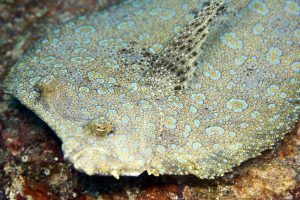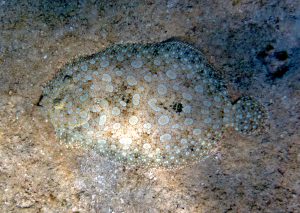Bothus lunatus, also known as the peacock flounder or plate fish is in the Lefteye Flounder (Bothidae) family. It is one of the most common flounders in coral reefs. They are usually 6 to 8 inches and thrive at a depth of 2 to 100 meters. They are found in the Bahamas, Caribbean, Bermuda, Gulf of Mexico, and Florida. Bothus lunatus is the Atlantic species of peacock flounder and Bothus mancus is the indo-pacific peacock flounder. This chapter is going to focus on the Atlantic species of peacock flounder, Bothus lunatus although there are many similarities between the two.

Peacock Flounder- Bothus lunatus by prilfish via Flickr
The peacock flounder is usually found in sandy areas in mangroves, seagrass meadows, and coral reefs. As a benthic organism as it spends most of its life on the ocean floor or slowly swimming slightly above.
They prey on small fish, which make up about 85.7% of its diet. However, it occasionally preys on octopi and small crustaceans such as marine shrimps and mollusks. They use their incredible camouflage to blend in with their surroundings to catch their meals. To catch their meals, they lie on the seabed partially submerged in the sediment and ambush their prey. When they aren’t on the seafloor, they remain close to the sediment and swim using short gliding motions with occasional bursts of fast motion when trying to avoid predators. As a diurnally active fish, they are most active during the day and typically rest at night.

Bothus lunatus (peacock flounder) (San Salvador Island, Bahamas) by James St. John via Wikimedia Commons
As juveniles, their eyes are on opposite sides of their head, and as they mature their right eye migrates towards the left. Having both eyes on the same side of the head helps when they lay down in the sand. They can see prey better as they have two eyes facing upwards and none facing the sand. They are great at camouflage and use their eyes to see their background and adjust their color to it. A problem arises if they have damaged sight when they try to camouflage because they can’t see the surroundings correctly. Their eyes are also spaced very far apart with males having an even wider gap between the left and right eyes.
When they are not camouflaged, their natural coloring is brown/grey/tan with bright blue, circular spots on their entire body, including their fins.
It takes the peacock flounder somewhere between 2 to 8 seconds to completely blend into their background. Different ages of peacock flounder face different kinds of predators. Juvenile peacock flounder face predation from shrimp, crab, and other fish. Adult flounder are prey for a variety of animals; striped bass, cod, bluefish, groupers, moray eels, stingrays, sharks, and more. The peacock flounder can live up to 10 years and breeds year-round. They always mate just before sunset and the mating lasts for a quick 15 seconds, on average.
The peacock flounder has been evaluated by the IUCN and, as of 2012, is of least concern when it comes to extinction likelihood. However, the peacock flounder is eaten by humans and overfishing and by-catch could potentially push it into a near threatened or vulnerable status in the future. It is said that by 2048 there will be ‘fishless oceans‘. Now, ‘fishless’ doesn’t mean no fish at all, at least immediately, but instead refers to a ‘collapse’ of the species… A species collapse means that 90% of the species are gone. With a 90% reduction in organisms, eventually, the number will end up climbing to 100%. This is mostly due to the issue of overfishing and the impact of climate change on ocean ecosystems. As of 2018, fishing industries are taking in 2 to 3 times as much fish than the oceans are able to support. This has caused about 85% of the WORLDS fish populations to be driven to near extinction or put on a fast track to extinction.
The information in this chapter is thanks to content contributions from Sarah Larsen
